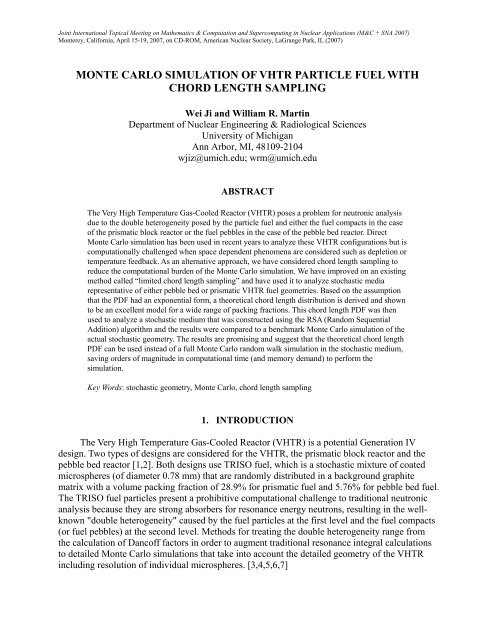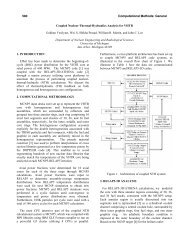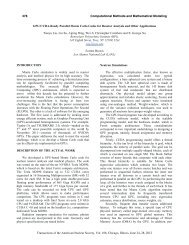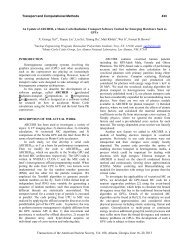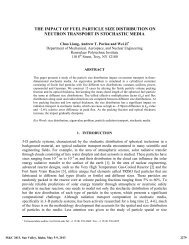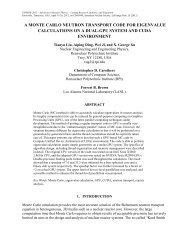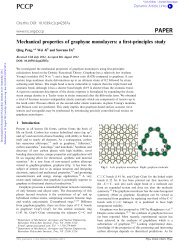Monte Carlo Simulation of VHTR Particle Fuel with Chord Length ...
Monte Carlo Simulation of VHTR Particle Fuel with Chord Length ...
Monte Carlo Simulation of VHTR Particle Fuel with Chord Length ...
You also want an ePaper? Increase the reach of your titles
YUMPU automatically turns print PDFs into web optimized ePapers that Google loves.
Joint International Topical Meeting on Mathematics & Computation and Supercomputing in Nuclear Applications (M&C + SNA 2007)<br />
<strong>Monte</strong>rey, California, April 15-19, 2007, on CD-ROM, American Nuclear Society, LaGrange Park, IL (2007)<br />
MONTE CARLO SIMULATION OF <strong>VHTR</strong> PARTICLE FUEL WITH<br />
CHORD LENGTH SAMPLING<br />
Wei Ji and William R. Martin<br />
Department <strong>of</strong> Nuclear Engineering & Radiological Sciences<br />
University <strong>of</strong> Michigan<br />
Ann Arbor, MI, 48109-2104<br />
wjiz@umich.edu; wrm@umich.edu<br />
ABSTRACT<br />
The Very High Temperature Gas-Cooled Reactor (<strong>VHTR</strong>) poses a problem for neutronic analysis<br />
due to the double heterogeneity posed by the particle fuel and either the fuel compacts in the case<br />
<strong>of</strong> the prismatic block reactor or the fuel pebbles in the case <strong>of</strong> the pebble bed reactor. Direct<br />
<strong>Monte</strong> <strong>Carlo</strong> simulation has been used in recent years to analyze these <strong>VHTR</strong> configurations but is<br />
computationally challenged when space dependent phenomena are considered such as depletion or<br />
temperature feedback. As an alternative approach, we have considered chord length sampling to<br />
reduce the computational burden <strong>of</strong> the <strong>Monte</strong> <strong>Carlo</strong> simulation. We have improved on an existing<br />
method called “limited chord length sampling” and have used it to analyze stochastic media<br />
representative <strong>of</strong> either pebble bed or prismatic <strong>VHTR</strong> fuel geometries. Based on the assumption<br />
that the PDF had an exponential form, a theoretical chord length distribution is derived and shown<br />
to be an excellent model for a wide range <strong>of</strong> packing fractions. This chord length PDF was then<br />
used to analyze a stochastic medium that was constructed using the RSA (Random Sequential<br />
Addition) algorithm and the results were compared to a benchmark <strong>Monte</strong> <strong>Carlo</strong> simulation <strong>of</strong> the<br />
actual stochastic geometry. The results are promising and suggest that the theoretical chord length<br />
PDF can be used instead <strong>of</strong> a full <strong>Monte</strong> <strong>Carlo</strong> random walk simulation in the stochastic medium,<br />
saving orders <strong>of</strong> magnitude in computational time (and memory demand) to perform the<br />
simulation.<br />
Key Words: stochastic geometry, <strong>Monte</strong> <strong>Carlo</strong>, chord length sampling<br />
1. INTRODUCTION<br />
The Very High Temperature Gas-Cooled Reactor (<strong>VHTR</strong>) is a potential Generation IV<br />
design. Two types <strong>of</strong> designs are considered for the <strong>VHTR</strong>, the prismatic block reactor and the<br />
pebble bed reactor [1,2]. Both designs use TRISO fuel, which is a stochastic mixture <strong>of</strong> coated<br />
microspheres (<strong>of</strong> diameter 0.78 mm) that are randomly distributed in a background graphite<br />
matrix <strong>with</strong> a volume packing fraction <strong>of</strong> 28.9% for prismatic fuel and 5.76% for pebble bed fuel.<br />
The TRISO fuel particles present a prohibitive computational challenge to traditional neutronic<br />
analysis because they are strong absorbers for resonance energy neutrons, resulting in the wellknown<br />
"double heterogeneity" caused by the fuel particles at the first level and the fuel compacts<br />
(or fuel pebbles) at the second level. Methods for treating the double heterogeneity range from<br />
the calculation <strong>of</strong> Danc<strong>of</strong>f factors in order to augment traditional resonance integral calculations<br />
to detailed <strong>Monte</strong> <strong>Carlo</strong> simulations that take into account the detailed geometry <strong>of</strong> the <strong>VHTR</strong><br />
including resolution <strong>of</strong> individual microspheres. [3,4,5,6,7]
Wei Ji and William R. Martin<br />
Explicit <strong>Monte</strong> <strong>Carlo</strong> simulation <strong>of</strong> the <strong>VHTR</strong> is very time-consuming and may not be<br />
feasible when space-dependent phenomena are accounted for, such as depletion and temperature<br />
feedback. We have studied an alternative methodology to analyze particle fuel that is based on<br />
chord length sampling (CLS).<br />
The CLS method was proposed in 1D geometry [8] to avoid explicitly modeling the<br />
stochastic mixture. The basic idea <strong>of</strong> CLS is to treat the stochastic geometry as a binary<br />
stochastic mixture whose two components are characterized by chord length probability<br />
distribution functions (PDFs). The <strong>Monte</strong> <strong>Carlo</strong> simulation proceeds by sampling a distance to<br />
collision in the current medium and comparing to a distance to boundary that was sampled from<br />
the chord length PDF for that medium. If a neutron crosses a boundary, this process is repeated<br />
in the second medium.<br />
A variation on CLS, called limited chord length sampling (LCLS) [9] was examined in 2D<br />
geometry for stochastic mixtures similar to TRISO fuel. For LCLS, chord length sampling is<br />
only done in the background medium, and conventional <strong>Monte</strong> <strong>Carlo</strong> is performed in the fuel<br />
region, which is a microsphere in the case <strong>of</strong> TRISO fuel. The results were promising but there<br />
were several areas that warranted further investigation: the results were limited to 2D, the chord<br />
length PDFs were based exclusively on empirical chord length distributions, microspheres near<br />
the external boundary needed to be treated carefully to avoid overlap <strong>with</strong> the boundary, and one<br />
needed to account for the fact that a neutron leaving a microsphere may backscatter into the same<br />
microsphere.<br />
A method very similar to LCLS had been developed earlier by Murata et al. [6,7] for the<br />
analysis <strong>of</strong> TRISO fuel. This method included chord length sampling to find the next<br />
microsphere, and then conventional <strong>Monte</strong> <strong>Carlo</strong> <strong>with</strong>in the microsphere. Two <strong>of</strong> the same issues<br />
as noted above for LCLS were present, including boundary overlap and backscattering into the<br />
same microsphere.<br />
To address these issues and yield a method capable <strong>of</strong> analyzing realistic TRISO fuel<br />
configurations, we have based the chord length PDF for the background medium on a theoretical<br />
model rather than an empirical model. We have validated the theoretical chord length PDF for<br />
the background medium <strong>with</strong> benchmark <strong>Monte</strong> <strong>Carlo</strong> simulations. These chord length PDFs<br />
were then used in a stochastic mixture representative <strong>of</strong> TRISO fuel <strong>with</strong> neutrons at the 6.67 eV<br />
resonance <strong>of</strong> U238. These calculations were performed using packing fractions ranging from<br />
pebble bed reactors (~ 5%) to prismatic block reactors (~ 29%) and the results were compared<br />
<strong>with</strong> a benchmark <strong>Monte</strong> <strong>Carlo</strong> code. The results are very promising and suggest that the LCLS<br />
method <strong>with</strong> theoretical PDFs can be used to analyze TRISO fuel for both pebble bed and<br />
prismatic block reactors.<br />
2. MONTE CARLO SIMULATION<br />
Figure 1 depicts a 3D binary stochastic mixture <strong>of</strong> microspheres <strong>with</strong>in a box <strong>of</strong><br />
background material. This is an actual realization <strong>of</strong> microspheres using the RSA algorithm<br />
Joint International Topical Meeting on Mathematics & Computation and 2/8<br />
Supercomputing in Nuclear Applications (M&C + SNA 2007), <strong>Monte</strong>rey, CA, 2007
MC <strong>Simulation</strong> <strong>of</strong> <strong>VHTR</strong> <strong>Particle</strong> <strong>Fuel</strong> <strong>with</strong> CLS Method<br />
[10,11] to add spheres to the box. We will now derive the chord length distribution that<br />
characterizes the background material in Figure 1.<br />
0.4<br />
0.3<br />
0.2<br />
0.1<br />
z-axis<br />
0<br />
-0.1<br />
-0.2<br />
-0.3<br />
-0.4<br />
0.4<br />
0.3<br />
0.2<br />
0.1<br />
y-axis<br />
0<br />
-0.1<br />
-0.2<br />
-0.3<br />
-0.4<br />
-0.4<br />
-0.3<br />
-0.2<br />
-0.1<br />
0<br />
x-axis<br />
0.1<br />
0.2<br />
0.3<br />
0.4<br />
Figure 1. A Realization <strong>of</strong> Microspheres Randomly<br />
Located Inside a Cube<br />
The key assumption we will make is that the distribution <strong>of</strong> chord lengths in the<br />
background material is exponential. This assumption will be confirmed <strong>with</strong> numerical results<br />
later in this paper. The following functional form for the chord length PDF may then be written:<br />
1<br />
p ( λ )<br />
(1)<br />
1<br />
= −λ1 < ><br />
⋅<br />
/ λ<br />
e<br />
1<br />
< λ1<br />
><br />
where λ<br />
1<br />
is the chord length between two microspheres and < λ 1<br />
> is the mean chord length.<br />
Consider a neutron trajectory that crosses N microspheres and background material regions<br />
in an infinite stochastic medium. Along this trajectory, the probability the neutron is in a<br />
microsphere region is given by:<br />
N⋅<br />
< λ2<br />
><br />
p<br />
2<br />
=<br />
(2)<br />
N⋅<br />
< λ > + N⋅<br />
< λ ><br />
1<br />
where < λ2<br />
> is the mean chord length inside a microsphere. This is identical to the volume<br />
packing fraction frac if the microspheres are randomly distributed in the background medium:<br />
2<br />
Joint International Topical Meeting on Mathematics & Computation and 3/8<br />
Supercomputing in Nuclear Applications (M&C + SNA 2007), <strong>Monte</strong>rey, CA, 2007
Wei Ji and William R. Martin<br />
< λ2<br />
><br />
frac =<br />
(3)<br />
< λ > + < λ ><br />
1<br />
4r<br />
Inserting < λ2<br />
>= into Equation (3) we find the following expression for < λ 1<br />
> :<br />
3<br />
4⋅r<br />
1−<br />
frac<br />
< λ<br />
1<br />
>= ⋅<br />
(4)<br />
3 frac<br />
Inserting Equation (4) <strong>with</strong> Equation (1), an analytical chord length PDF is obtained:<br />
2<br />
3 frac<br />
−λ1⋅<br />
⋅<br />
4⋅r<br />
1−<br />
frac<br />
3 frac<br />
p(<br />
λ<br />
1)<br />
= ⋅ ⋅e<br />
(5)<br />
4⋅<br />
r 1−<br />
frac<br />
This is a general formula for the chord length PDF in the background medium as a function<br />
<strong>of</strong> the packing fraction and microsphere radius. An equivalent expression was derived earlier by<br />
Murata et al. [6] using the definition <strong>of</strong> the nearest neighbor distribution.<br />
3. VALIDATION OF THE CHORD LENGTH PDF<br />
The theoretical PDF given in Equation (5) was compared to a benchmark <strong>Monte</strong> <strong>Carlo</strong><br />
simulation <strong>of</strong> the distribution <strong>of</strong> chord lengths between two microspheres in a medium <strong>of</strong><br />
dispersed microspheres <strong>with</strong> a range <strong>of</strong> packing fractions. The <strong>Monte</strong> <strong>Carlo</strong> simulation<br />
proceeded by first using RSA [11] to construct a realization <strong>of</strong> a stochastic mixture similar to that<br />
depicted in Figure 1. A microsphere near the center <strong>of</strong> the cube is selected and an emission point<br />
is randomly chosen on the surface <strong>of</strong> the microsphere. An exiting neutron is then sampled <strong>with</strong> a<br />
cosine current distribution. A total <strong>of</strong> 4,000 realizations were constructed and for each realization,<br />
there were 50 sampled points and 100,000 sampled directions for each point, yielding 20 billion<br />
sampled chord lengths. The chord length was determined by tracking the neutron to the next<br />
microsphere. Figure 2 shows the resultant distribution <strong>of</strong> chord lengths as a function <strong>of</strong> packing<br />
fraction, along <strong>with</strong> the theoretical PDF (dotted lines) from Equation (5). The comparison<br />
between these two sets <strong>of</strong> results shows very good agreement <strong>with</strong> improved results for smaller<br />
packing fractions.<br />
Joint International Topical Meeting on Mathematics & Computation and 4/8<br />
Supercomputing in Nuclear Applications (M&C + SNA 2007), <strong>Monte</strong>rey, CA, 2007
MC <strong>Simulation</strong> <strong>of</strong> <strong>VHTR</strong> <strong>Particle</strong> <strong>Fuel</strong> <strong>with</strong> CLS Method<br />
10<br />
<strong>Chord</strong> length distribution PDFs<br />
at 5.76%, 10%, 15% and 28.9% volume packing fractions<br />
1<br />
PDFs (Log Scale)<br />
0.1<br />
0.01<br />
0.001<br />
28.92% 15.00% 10.00%<br />
5.76%<br />
0.0001<br />
0 0.4 0.8 1.2 1.6 2 2.4 2.8 3.2 3.6 4 4.4 4.8 5.2 5.6 6 6.4 6.8 7.2 7.6 8<br />
<strong>Chord</strong> <strong>Length</strong> (cm)<br />
Figure 2. Comparison <strong>of</strong> Theoretical and Benchmark<br />
<strong>Chord</strong> <strong>Length</strong> Distributions<br />
4. MONTE CARLO SIMULATION OF STOCHASTIC MEDIA USING LCLS<br />
The chord length PDF given in Equation (5) was then used to simulate neutron transport in<br />
stochastic mixture <strong>of</strong> microspheres <strong>with</strong> a range <strong>of</strong> packing fractions. The microsphere geometry<br />
is representative <strong>of</strong> TRISO fuel for the NGNP [1]. The microsphere outer diameter is 0.78 mm<br />
and the fuel kernel diameter is 0.350 mm. The cross sections for the graphite matrix region and<br />
the microspheres were obtained from the BNL website [12] for neutrons at 6.67 eV. The four<br />
microsphere coatings were lumped into a single coating. Although the coating region and the<br />
graphite matrix region were distinct regions for the <strong>Monte</strong> <strong>Carlo</strong> simulation, these regions had<br />
identical cross sections obtained by homogenizing the materials in these two regions [3].<br />
The stochastic mixture <strong>of</strong> microspheres and graphite matrix was contained in a cubical box<br />
<strong>with</strong> edge 8 cm. The microspheres were added to the box using RSA <strong>with</strong> packing fractions<br />
ranging from 5.76% to 29.8%. Incoming neutrons were emitted from a point at the center <strong>of</strong> the<br />
left side <strong>with</strong> a cosine current angular distribution. The average absorption rate in the<br />
microspheres was tallied, along <strong>with</strong> three leakage rates: reflection out the left wall, transverse<br />
leakage across the upper, lower and side walls, and transmission leakage across the right wall.<br />
These benchmark <strong>Monte</strong> <strong>Carlo</strong> results were then compared <strong>with</strong> the results using chord length<br />
Joint International Topical Meeting on Mathematics & Computation and 5/8<br />
Supercomputing in Nuclear Applications (M&C + SNA 2007), <strong>Monte</strong>rey, CA, 2007
Wei Ji and William R. Martin<br />
sampling for the stochastic mixture. The benchmark <strong>Monte</strong> <strong>Carlo</strong> results were based on 100<br />
realizations (different stochastic mixtures using RSA) <strong>with</strong> 10,000,000 particle histories per<br />
realization. The results are given in Table I.<br />
Figure 3. <strong>Monte</strong> <strong>Carlo</strong> <strong>Simulation</strong> Geometry<br />
The results in Table I show very good agreement between the LCLS method and the<br />
benchmark <strong>Monte</strong> <strong>Carlo</strong> simulations. For all packing fractions, the absorption rate was <strong>with</strong>in<br />
0.15%, <strong>with</strong> no apparent dependence on packing fraction. For the reflection and transverse<br />
leakage rates, the agreement is <strong>with</strong>in 1% for the low packing fractions and somewhat higher for<br />
high packing fractions, but it seems that the higher relative errors occur <strong>with</strong> relatively small<br />
absolute leakage rates, such as the transmission rates for all cases, and the transverse leakage<br />
rates for the high packing fraction cases.<br />
We have also considered two extensions to the LCLS method for the analysis <strong>of</strong> TRISO<br />
fuel. The first is to account for the fact that a neutron exiting a microsphere in a highly scattering<br />
medium will have a reasonable probability <strong>of</strong> scattering back into the same microsphere. This<br />
was accounted for in LCLS by “remembering” the last microsphere the neutron exited and<br />
including its boundary as a potential surface to be tracked to along <strong>with</strong> a sampled chord length.<br />
If a neutron enters another microsphere, this memory is erased. This results in an improvement in<br />
the range <strong>of</strong> 0.1% to 2.0% depending on the specific configuration. Normally, for cases <strong>with</strong> low<br />
scattering cross sections (1. 0cm -1 ) in background material, the backscatter<br />
effect can approach 2.0%.<br />
The second extension is to account for microspheres that are close to the outer boundary <strong>of</strong><br />
the box. If a neutron enters a microsphere in the interior <strong>of</strong> the box, the incoming direction is<br />
sampled uniformly on the unit hemisphere <strong>with</strong> respect to the outer normal. However, for a<br />
microsphere near the boundary, the resultant direction may be equivalent to letting the<br />
microsphere overlap the boundary. This was addressed by rejection sampling until the<br />
Joint International Topical Meeting on Mathematics & Computation and 6/8<br />
Supercomputing in Nuclear Applications (M&C + SNA 2007), <strong>Monte</strong>rey, CA, 2007
MC <strong>Simulation</strong> <strong>of</strong> <strong>VHTR</strong> <strong>Particle</strong> <strong>Fuel</strong> <strong>with</strong> CLS Method<br />
microsphere was wholly inside the boundary. Preliminary results indicate this is an important<br />
effect for realistic TRISO applications.<br />
Table I. The results for <strong>VHTR</strong> geometry model<br />
(matrix) Σ t,1 =0.4137cm -1 , Σ a,1 =0.0cm -1 , Σ s,1 =0.4137cm -1 ;<br />
(coatings) Σ t,2 =0.4137cm -1 , Σ a,2 =0.0 cm -1 , Σ s,2 =0.4137cm -1 ;<br />
(fuel kernel) Σ t,3 =228.4cm -1 , Σ a,3 =189.7cm -1 , Σ s,3 =38.7cm -1<br />
absorption rate<br />
Solution ∫ Σ<br />
a<br />
⋅φ(<br />
r)<br />
dr<br />
V3<br />
Method<br />
in fuel kernels<br />
1σ<br />
Benchmark<br />
(time:120,695s)<br />
chord length<br />
(10,000,000)<br />
(time: 142s)<br />
Benchmark<br />
(time:65,244s)<br />
chord length<br />
(10,000,000)<br />
(time: 162s)<br />
Benchmark<br />
(time:56,485s)<br />
chord length<br />
(10,000,000)<br />
(time: 174s)<br />
Benchmark<br />
(time:32,124s)<br />
chord length<br />
(100,000,000)<br />
(time: 2,031s)<br />
reflection<br />
leakage via (–z)<br />
1σ<br />
Volume packing fraction at 5.76%<br />
0.668 ± 0.2293 ±<br />
0.001 0.0004<br />
0.667 ± 0.2279 ±<br />
0.001 0.0001<br />
Volume packing fraction at 15.00%<br />
0.856 ± 0.1332 ±<br />
0.001 0.0003<br />
0.856 ± 0.1320 ±<br />
0.001 0.0001<br />
Volume packing fraction at 20.00%<br />
0.886 ± 0.1101 ±<br />
0.001 0.0002<br />
0.886 ± 0.1094 ±<br />
0.001 0.0001<br />
Volume packing fraction at 28.9%<br />
0.9147 ± 8.47e-2 ±<br />
0.0001 0.01e-2<br />
0.9136 ± 8.60e-2 ±<br />
0.0001 0.01e-2<br />
transverse<br />
leakage via (±x,<br />
±y)<br />
1σ<br />
9.80e-2 ±<br />
0.01e-2<br />
9.97e-2 ±<br />
0.01e-2<br />
1.102e-2 ±<br />
0.001e-2<br />
1.149e-2 ±<br />
0.001e-2<br />
3.71e-3 ±<br />
0.01e-3<br />
3.85e-3 ±<br />
0.01e-3<br />
5.75e-4 ±<br />
0.01e-4<br />
6.10e-4 ±<br />
0.01e-4<br />
transmission<br />
leakage via (z+)<br />
1σ<br />
5.00e-3 ±<br />
0.02e-3<br />
5.18e-3 ±<br />
0.02e-3<br />
1.44e-4 ±<br />
0.01e-4<br />
1.50e-4 ±<br />
0.04e-4<br />
2.21e-5 ±<br />
0.02e-5<br />
2.40e-5 ±<br />
0.15e-5<br />
0.84e-6 ±<br />
0.03e-6<br />
0.75e-6 ±<br />
0.09e-6<br />
Joint International Topical Meeting on Mathematics & Computation and 7/8<br />
Supercomputing in Nuclear Applications (M&C + SNA 2007), <strong>Monte</strong>rey, CA, 2007
Wei Ji and William R. Martin<br />
5. CONCLUSIONS<br />
A chord length distribution PDF was derived for a binary stochastic mixture media in 3D<br />
geometry assuming the PDF had an exponential form. The exponential form <strong>of</strong> the PDF was<br />
validated against a benchmark calculation using a direct ray emitting method to determine the<br />
chord length distribution in stochastic mixtures <strong>with</strong> varying packing fractions.<br />
As a specific application for <strong>VHTR</strong> geometry model, the transport <strong>of</strong> resonance energy<br />
neutrons in a stochastic mixture representative <strong>of</strong> <strong>VHTR</strong> fuel was analyzed <strong>with</strong> this method for<br />
several different volume packing fractions. The results were compared against a benchmark<br />
<strong>Monte</strong> <strong>Carlo</strong> simulation using 100 realizations and 10 million histories per realization. The<br />
results indicate that the LCLS method can be used for realistic <strong>VHTR</strong> configurations.<br />
ACKNOWLEDGMENTS<br />
This work was funded by U.S. DOE NERI Grant DE-FC07-06ID14745.<br />
REFERENCES<br />
1. P.E. MacDonald, et al., “NGNP Preliminary Point Design – Results <strong>of</strong> the Initial Neutronics<br />
and Thermal-Hydraulic Assessments During FY-03,” INEEL/EXT-03-00870 Rev. 1. Idaho<br />
National Engineering and Environmental Laboratory (2003).<br />
2. Chang H. Oh, et al., “Development <strong>of</strong> Safety Analysis Codes and Experimental Validation<br />
for a Very High Temperature Gas-Cooled Reactor,” INL/EXT-06-01362 Idaho National<br />
Engineering and Environmental Laboratory (2006).<br />
3. W. Ji, J.L. Conlin, W.R. Martin, J.C. Lee and F.B. Brown, “Explicit Modeling <strong>of</strong> <strong>Particle</strong> <strong>Fuel</strong> for the<br />
Very-High Temperature Gas-Cooled Reactor,” Trans. Am. Nucl. Soc., 92, pp.236-238 (2005)<br />
4. W. Ji, J.L. Conlin, W.R. Martin, J.C. Lee and F.B. Brown, “Neutronic Analysis to Support Validation<br />
<strong>of</strong> Safety Analysis Codes for the <strong>VHTR</strong>,” Trans. Am. Nucl. Soc., 93, pp.931-933 (2005)<br />
5. F.B. Brown and W.R. Martin, “Stochastic Geometry Capability in MCNP5 for the Analysis <strong>of</strong> <strong>Particle</strong><br />
<strong>Fuel</strong>,” Annals <strong>of</strong> Nuclear Energy, 31, pp.2039-2047 (2004)<br />
6. I. Murata, T. Mori and M. Nakagawa, “Continuous Energy <strong>Monte</strong> <strong>Carlo</strong> Calculations <strong>of</strong><br />
Randomly Distributed Spherical <strong>Fuel</strong>s in High-Temperature Gas-Cooled Reactors based on a<br />
Statistical Geometry Model,” Nucl. Sci. Eng., 123, pp.96-106 (1996)<br />
7. I. Murata, et al., “New Sampling Method in Continuous Energy <strong>Monte</strong> <strong>Carlo</strong> Calculation for<br />
Pebble Bed Reactors,” J. Nucl. Sci. Tech., 34, pp.734-744 (1997)<br />
8. G.B. Zimmerman and M.L. Adams, “Algorithms for <strong>Monte</strong> <strong>Carlo</strong> <strong>Particle</strong> Transport in<br />
Binary Statistical Mixtures,” Trans. Am. Nucl. Soc., 64, pp.287-288 (1991)<br />
9. T.J. Donovan and Y. Danon, “Application <strong>of</strong> <strong>Monte</strong> <strong>Carlo</strong> <strong>Chord</strong>-<strong>Length</strong> Sampling<br />
Algorithms to Transport through a Two-Dimensional Binary Stochastic Mixture,” Nucl. Sci.<br />
Eng., 143, pp.226-239 (2003)<br />
10. S. Widom, "Random Sequential Addition <strong>of</strong> Hard Spheres to a Volume," J. Chem. Phy. 44, 3888-3894<br />
(1966).<br />
11. F.B. Brown, “A Fast RSA Method for <strong>Fuel</strong> <strong>Particle</strong> Packing,” Trans. Am. Nucl. Soc., 94,<br />
pp.571-573 (2006).<br />
12. http://www.nndc.bnl.gov/exfor3/endf00.htm .<br />
Joint International Topical Meeting on Mathematics & Computation and 8/8<br />
Supercomputing in Nuclear Applications (M&C + SNA 2007), <strong>Monte</strong>rey, CA, 2007


